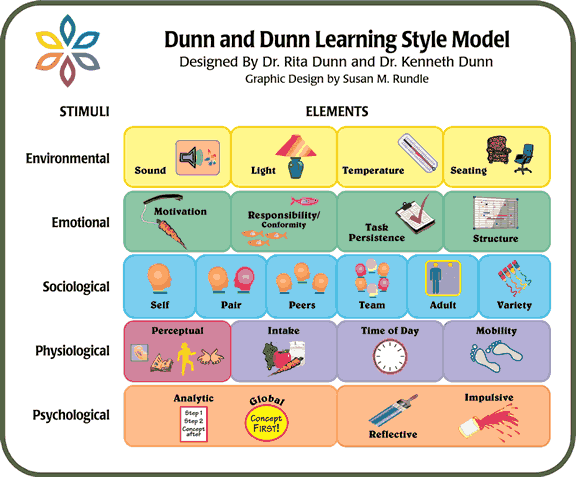The Dunn and Dunn Learning Styles Inventory Model.
The Dunn and Dunn Learning Styles Inventory uses a comprehensive learning style model. The inventory measures environmental, emotional, sociological, physiological, and psychological preferences as they affect learning. Dunn and Dunn is one of the best Learning Styles Inventories you can use to enhance your child’s learning.
When you use several learning styles models, you can create a perfect learning environment for your child. You can also select great programs to improve your child’s learning.
Learning Styles Learning Environments.
By creating the best learning environment for your learner, you can improve your child’s learning. Important things such as lighting, quietness, timing, the learning environment, solitary or group learning, etc., affect your child’s learning. By paying attention to the details, you can create the best learning environment for your child.
Here is a graphic to help you understand the focus of the Dunn and Dunn Learning Styles Model:

How to Create Better Learning for Your Child Using Learning Styles.
You can use the above graphic to figure out how to make your child’s best learning environment. Unfortunately, you can no longer assess your child with the Dunn and Dunn learning styles assessment.
However, you can assess your child’s learning style. To do so, carefully looking at each area of the Dunn and Dunn learning styles model section by section. Then determine the way(s) YOUR child copes well with the environment.
An example Using the Environmental Domain:
The Way They Learn
57% OffTo build a friendly learning environment for your child, you would consider:
- Sound – Does your learner like silence, light background noise, or a noisy environment?
- Light – Does your child prefer bright fluorescent or incandescent light, dim light, or natural light?
- Temperature – Does your learner prefer a cold, cool, warm, or toasty environment?
- Seating – Does your child prefer a lounge chair, solid high-back chair, lying on the floor, or another position for reading or studying?
Other Learning Domains:
In the Emotional Domain, consider your child’s level of motivation, task persistence, conformity, and need for a structured environment.
The Sociological Domain is great for considering your child’s preference for studying alone, in pairs, with peers, in a team environment, with an adult as a teacher, or in a variety of social settings.
In the Physiological Domain, you consider your child’s preference for the modes of learning in the VAKT model (auditory, visual, tactile, and kinesthetic). You also consider your child’s best time of day for learning activities. And look at his preference for information intake methods and mobility/movement for better learning.
In the Psychological Domain, you’ll consider your child’s learning style as it falls into an analytic/global thinking style or a more impulsive/reflective style.
Summary of the Dunn and Dunn Learning Styles Inventory:
By analyzing your child’s needs in the five different domains in the Dunn and Dunn model, you will build a better understanding of your child’s individual learning needs. Determining your child’s style based upon the Dunn and Dunn model is no longer available via their learning styles inventories.
SO, I suggest looking at the the Dunn and Dunn learning styles inventory models section by section, and determine what your child prefers. You can likely figure out what they like and their natural desires and needs through daily observations. The Dunn and Dunn learning styles inventory is a great tool for understanding how you can create an ideal learning environment for your child. 😉
Western Governors University has a brief webpage that further discusses three environmentally-based learning styles, if you’d like a bit of additional information.









